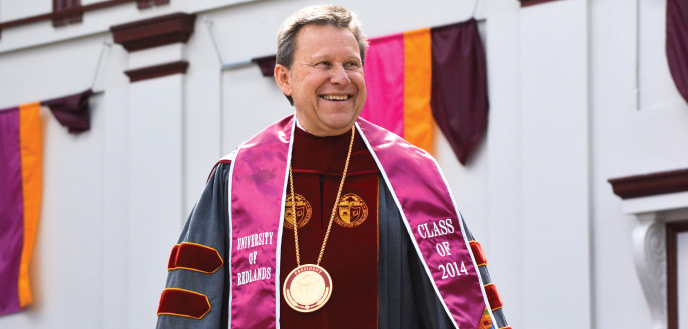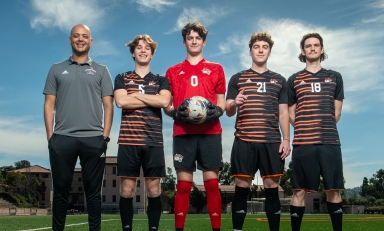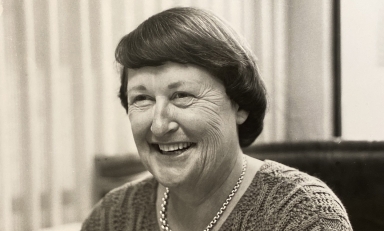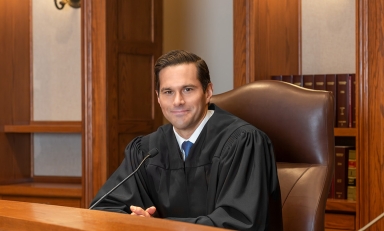
There's no one path to becoming a college or university president, but a handful of Oxy alumni have found the way. It's a job with infinite challenges—and innumerable rewards
By Lori L. Ferguson
The hours tend to be long. Your time is not your own. Your to-do list can be measured in years, even decades. You're always asking people for money. Crises can come out of nowhere. But the pay can be pretty good. And the commute is usually an easy one. You get to pal around with visiting dignitaries, brilliant minds, and the occasional kid in a mascot costume.
Over the last century, Oxy has produced more than two dozen presidents of colleges and universities nationwide. (If there's a common thread to their career paths, it's that there's no common thread.) No fewer than five alumni currently hold that distinction, at institutions ranging from 1,400 to 21,000 students and enjoying terms that range from less than six months to more than two decades. Time and again their stories dovetail, their experiences resonate, their challenges recur, and the same conclusion resounds: They can't imagine doing anything else.
The career chooses you.
"I don't know that I ever aspired to be a university president," concedes Sharon Gaber '85, regarding her new role at the University of Toledo (since July). "I just realized that I enjoy bringing people together and moving things forward." An urban studies and economics double major at Oxy, Gaber came to Toledo after six years as provost and vice chancellor for academic affairs at the University of Arkansas. There, she says, she worked for a wonderful chancellor who said, "You realize that someday you'll be a president." "Over time, that seemed more logical," Gaber recalls with a chuckle.
"I never dreamt of becoming a college president," admits Erik Bitterbaum '75, president of the State University of New York (SUNY), Cortland. "I was in love with biology, a passion fostered by my work with environmental biologist Martin Morton while an undergrad at Occidental. I worked with Professor Morton on a research project involving ground squirrels, and it was such a unique experience that it changed my career path—I'd been planning to go to med school, but I decided I wanted to research and teach like Marty." Bitterbaum did teach for a time, but eventually moved into administrative work, beginning as assistant and then associate provost at Nebraska (Lincoln) Wesleyan University and moving into increasingly senior positions at various institutions before taking over as president of SUNY Cortland in 2003. "During my time in Nebraska, I was given the opportunity to build academic programs, which I found both exciting and fulfilling," Bitterbaum recalls. "I eventually thought, 'Since I enjoy effecting change at this level, why not try to transform a whole institution?'"
"I've hardly traveled a linear pathway to the presidency," says Ralph Kuncl '70, president of University of Redlands since 2012. A professor of brain and cognitive sciences and neurology, Kuncl enjoyed a distinguished career as a medical research scientist for more than
25 years, making significant inroads into the treatment of amyotrophic lateral sclerosis (Lou Gehrig's disease). "For a research scientist, the focus becomes ever more narrow—it's the nature of the beast, but it's confining in a way," Kuncl explains. "Yet I think it's a natural progression of a career to become outwardly directed—I certainly did. It became clear to me that I have a high need for variety and change. I served as a provost at two institutions and although I enjoyed that work very much, I wanted do to something that would have an impact on an entire university, and by extension the world around me."
"I didn't start out with presidency as a career plan," says Karen Gould '70, president of Brooklyn College since 2009 and the first woman to hold the position. An internationally known scholar in the field of French-Canadian literature, Gould originally planned to spend her life in the classroom. "I loved being a faculty member, teaching and doing research." But, Gould says, she increasingly found herself being asked to join committees, first in her own department and then across her institution. "I found that I enjoyed the work and I received a lot of encouragement as I transitioned to increasingly senior positions as a dean and then a provost, so when I was asked to apply for the presidency at Brooklyn, I was motivated by the mission of the college: providing affordable access to an outstanding education."
"I've always worked in higher ed, from age 4 on," James Dennis '66 says with a chuckle. "My dad [legendary coach and athletic director Roy Dennis '33] was on the faculty at Occidental for many years, so I grew up on the campus—I thought the whole place was mine. Over the years I had jobs in the bookstore, the physical plant, the library, the swimming pool, and the athletic training room, among other places."
In all seriousness, Dennis never assumed that he'd make a life in higher education. But after earning a Ph.D. in administration from USC, Dennis joined the USC faculty and later entered the administrative branch, rising to the rank of vice president for student affairs over the course of more than 25 years. When he was invited to apply for the president's job at McKendree, Dennis jumped. "The lure of returning to a smaller institution that was similar to the size of Occidental was strong, and I thought and hoped that I could make a difference," he recalls.
Fundraising is never easy.
Dennis has realized his wish, presiding over a period of tremendous growth at McKendree—expanding enrollment, course offerings, and the institution's physical plant and enhancing the quality of students and faculty alike. (In 2004, McKendree's faculty proclaimed the years 1994 to 2004 "The James M. Dennis Transformational Leadership Decade.") During his tenure, Dennis has also increased the financial strength of McKendree significantly, boosting financial aid for the school by more than 900 percent while more than tripling the operating budget. Yet despite his successes, Dennis says that fundraising is a daily battle. "Development work is just plain challenging," he notes. "You have to help people understand your goals and hope they'll buy in."
Gould concurs. "The most important ingredient in fundraising is vision," she says. "That's what resonates with donors who really want to stretch and give a gift that makes a difference."
Fundraising for medical research is in many ways much easier than fundraising for a university for precisely that reason, Kuncl points out. "When you're raising money to fight a disease, you have many grateful patients who are eager to help further your research, whereas in education, as the old joke goes, 'No one ever died from French.'" People want to be philanthropic, Kuncl asserts. "You simply have to provide a meaningful opportunity for them to do so, and the key to success is being 'donor-centric,' gaining an understanding of donors interests and concerns by cultivating relationships."
"I spend a lot of time on the road fundraising," admits Bitterbaum, "but I enjoy it." As president, he has overseen $250 million in new construction and renovation on the Cortland campus and shepherded a successful $25-million capital campaign, the largest in SUNY Cortland's history. "You have to be active, but if you enjoy people, it's incredibly rewarding because you're asking for support that enables your institution to thrive by providing resources for students to attend school, faculty to do research and buy equipment, and the administration to improve the physical plant."
"I was fortunate enough to see the impact that effective fundraising can have on a campus during my time at the University of Arkansas—it's transformative," says Gaber, part of a senior team that raised $1 billion for the university under the guidance of Chancellor David Gearhart, whom she characterizes as "a consummate professional and great teacher." "Fundraising is a huge part of any presidency and an ongoing challenge—you've always got to be identifying priorities, communicating with your constituents and encouraging donors to invest in the institution."
You answer to many masters.
The biggest challenge, in fundraising and leading in general, observes Dennis, is balancing the needs and interests of the faculty, staff, alumni, and students against the reality of available resources. "Every constituency wants resources that they see others enjoying so that they can realize their dreams, and it's not always possible to fulfill those wishes."
Success lies in managing those expectations, according to Gould. "As president, you're always balancing the interests and agendas of your various stakeholders with limited resources—sometimes you're even making decisions about what you won't do. You need to generate excitement about new initiatives and ideas, while never losing sight of your primary mission: to succeed as individuals and contribute to the broader society." And perhaps most challenging, Gould notes, is giving people hope when things aren't always as easy as you'd like them to be. "You have to be engaged and build solid relationships; they're what carry you over the rough patches."
"Two skills that have served me well in dealing with constituents, which carry over from my former life as a physician, are empathetic listening and evidence-based decisionmaking," says Kuncl. "I listen in a way that matters and indicates to people that they have been heard, something that's as important in a faculty meeting or a board retreat as it is in a doctor's office. I'm also a scientist—I make decisions informed by evidence rather than only gut reactions and intuition, which is critically important when you're dealing with the sorts of complex issues that arise in leading a university."
Bitterbaum, too, is deeply committed to active listening and practicing 'stewardship of place.' "Universities have a responsibility to their communities, both internal and external—we must reach out and lift them up." When Bitterbaum first arrived in Cortland, he conducted a listening tour, hosting breakfasts with community leaders and seeking input on how everyone could work together to make Cortland thrive. "I'm always working to build bridges," he notes.
"It's imperative that a president have the ability to talk to people and engage with them," notes Gaber. "Leading a university is different than leading a corporate entity where the CEO tends to dictate; here I'm leading through a participatory model. I'm answering to a variety of stakeholders and managing to many different metrics, so strong communication is essential."
There's no better job.
Although long hours are commonplace and pressure to secure increasing amounts of funding ever present, not one of the five has a tinge of regret over their decision to pursue the president's chair. "I have a day that I love, and that's Commencement," says Bitterbaum. "Over the course of four years, I get to know our students and watch them transform into adults ready to take on the world. It brings me great pleasure to see the contributions that faculty and staff have made to their lives and witness their growth."
"Serving as a college president is a remarkable opportunity to lead in directions that change lives," Gould notes. "My style of leadership is to hire and retain great people, define our goals, and work together to get there. Collaborating with talented people to transform lives and further democratize our society through education is incredibly rewarding."
"I love this job—it's so much more enlivening than anything I've ever done," Kuncl says. "The breadth of activities, the warmth of interactions with various constituencies, the mentoring time with students—it's all incredible."
"I truly learn from our students and still believe I have something to give them in return," Dennis says. "I'm always thinking about how we're going to do the next thing—I'm still driven every day to try to meet people's expectations for McKendree." It's hard work, he concedes, but "I get up every morning and go play president—what could be better than that?"
Ferguson wrote "Guided by Voices" in the Winter issue.



